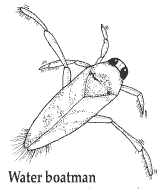Before Visiting a Wetland
From the small phantom midge to the great blue heron, wetlands are home to all kinds of wildlife. To prepare students:
- Watch wetlands video.
- See if there is a wetlands discovery trunk near you to borrow.
- Have students look for specific species in the wetland. Here are some common creatures they may discover. Have them draw at least one new plant or animal they saw on the back of the paper.
Common wetland insects with uncommon names are the phantom midge and the water boatman.
Damselfly
The blue damselfly has a pale blue-banded black abdomen. The nymphs live in sluggish streams.
The blackwing damselfly is a common black-winged 55mm damselfly with a metallic green body. The female has a white dot near the apex of each wing. Nymphs live in streams of the pine-and-oak woods of eastern Texas.
The Phantom midge got its "phantom" name because its larva is clear and nearly invisible. It eats small, aquatic crustaceans such as water fleas. Midges are eaten by water spiders. The larva hatches into a small fly that looks like a mosquito but does not bite.
Water Boatman
The water boatman was named for its two very long legs which are used just like paddles. This insect will attach itself to plants at the bottom of a pond and breathe from a bubble of air stored around its body. Boatmen eat plants and algae. They are eaten by fish.
American Avocet
The American avocet is a shorebird that has an interesting way of protecting its nest. The avocet female lays her eggs on the ground in slight depressions in mud or grass. To protect such an exposed nest, a parent avocet screams an alarm whenever a predator is spotted. This call brings all the avocets together and as a group they drive the intruder away.
Muskrat
The muskrat is a common resident of wetlands. This rodent likes to feed on cattails, a plant that is abundant in marshes. Muskrats use cattails to build their lodges. A muskrat lodge looks like a small beaver lodge. Canada geese sometimes build their nests on top of muskrat lodges because this height provides the geese with a lookout for predators.
Garter Snake
If you are a careful observer, you might see a garter snake swimming in the water. Garter snakes are found throughout Texas and are excellent swimmers. They eat insects, earthworms and frogs. These snakes can live for up to six years.
Great Blue Herron
You won't want to miss one of the largest birds found in a marsh. The great blue heron has a wingspan of six feet! This bird uses its sharp bill to spear fish, frogs and snakes.
Texas Treasures: Wetlands (PDF

